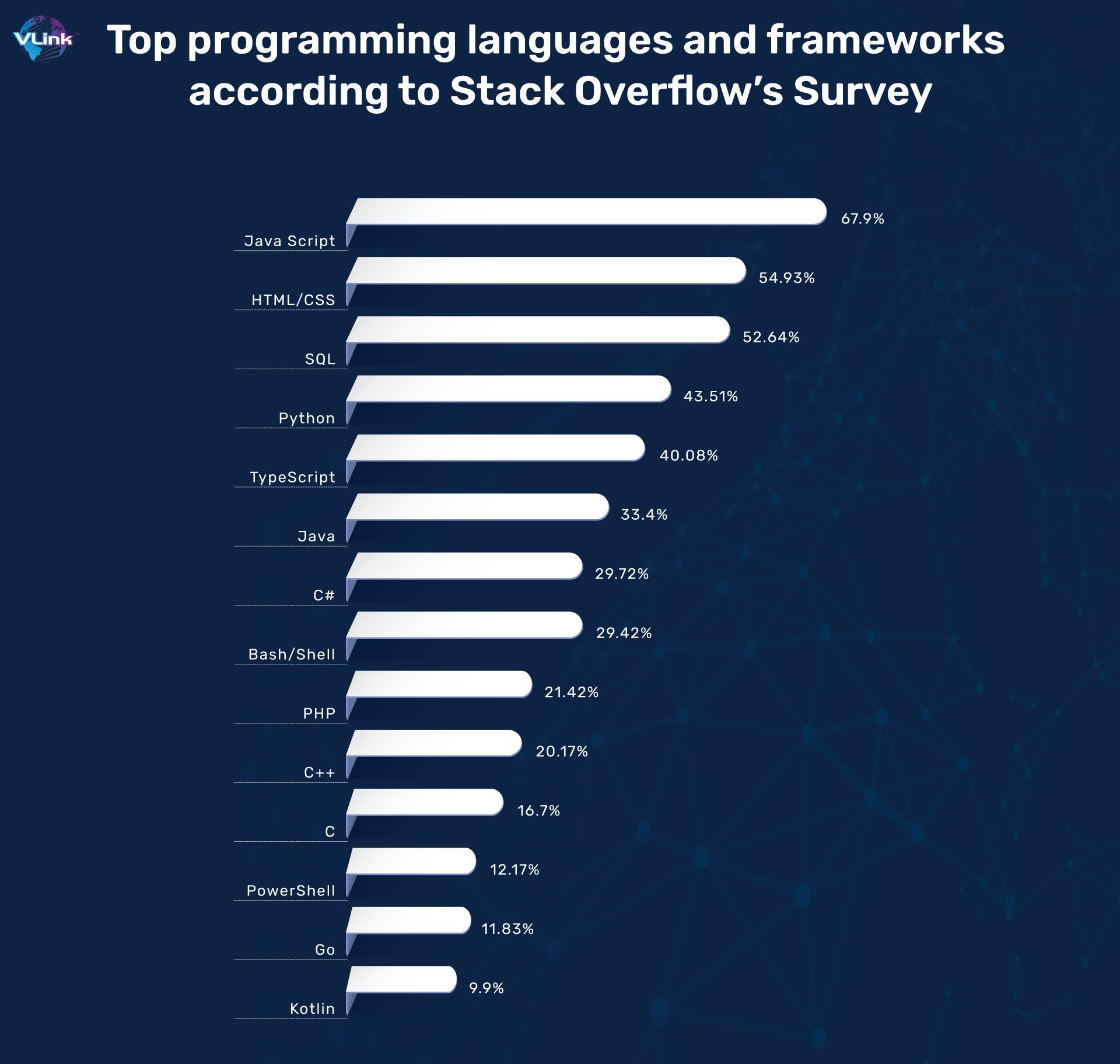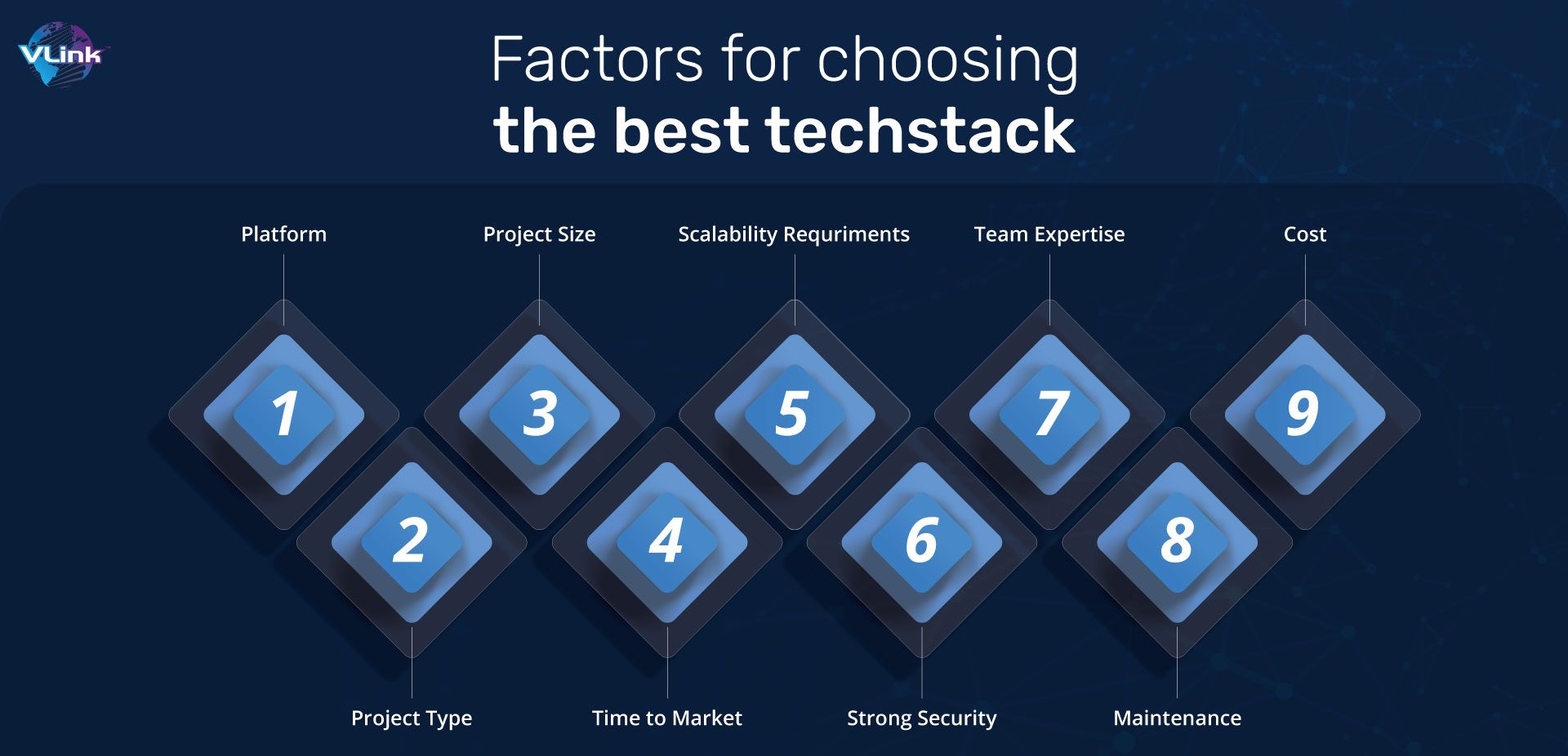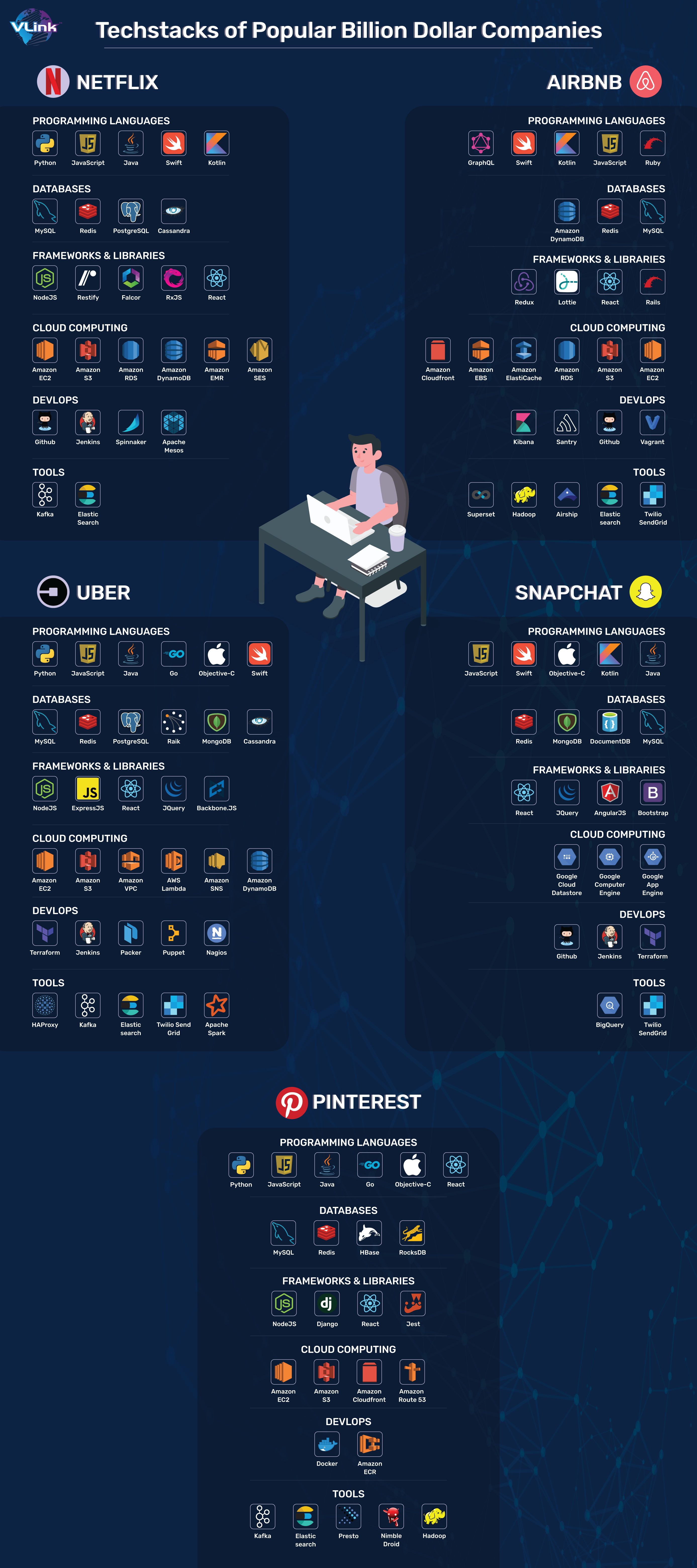How to Choose the Right Tech Stack for Your Development Project?
What is a tech stack? Which technology is important for your project? And how can you select the right tech stack for your mobile & web app development projects? This blog sheds light on several tech stack types & factors that dominate the best choice.
 5 minute
5 minute

Choosing the right tech stack is crucial in building a successful digital software product. Why? Web & mobile app development is about designing a nice UI and convenient UX and creating a stable, secure & maintainable app. It'll win your customer's hearts and scale your business.
Suppose you look at popular big brands like Netflix, Uber or Amazon. In that case, you will notice that besides efficient marketing strategy, modern design and great CX, an important part of their success depends on properly chosen tech stacks.
But the main concern is how to select the right tech stack for your future product.
This blog will give you an overview of tech stacks and factors to find the right one to help you thrive and establish your company's position in the market.
Table of Content:
- What is a tech stack?
- What are popular tech stacks?
- How to choose the right tech stack for your development project?
- Techstacks of Popular Billion-Dollar Companies
- Choose the Best Tech Stack for Your Development Project.
- Conclusion!
- FAQs–
What is a Tech Stack?
A technology stack is a set of tools and technologies programmers use for mobile and web app development services. It comprises programming languages, frameworks, libraries, patterns, UI/UX components, hardware modules, development tools, and different programming approaches.

All these aspects come together to define what the development project will look like and its functions.
Each software or application is built of multiple interdependent layers that communicate. Each layer performs a different function and requires different tools to build.
Primarily, all these different mobile app development technologies, and frameworks are divided into three parts, each servicing a different software layer. The three parts are:
- Front-end – This is the client-side structure.
- Back-end – This is the server-side structure.
- Middleware – This translation layer connects the front and back ends.
Each part of the stack offers a wide range of technologies, making it very confusing to pick the right tech stack. Before we get to choosing the stack, the first step is to understand the different layers of a stack and the functions they perform.
Structure of a Technology Stack
Frontend Development Technology stack
The front end refers to all the elements the users see on their screens and interact with.
There are three major frontend coding languages:
- HTML Markup Language is used to display content on the browser.
- CSS is used for the stylistic elements of the content, such as font and indentation.
- JavaScript helps build all the interactive parts of the application.
- Apart from these languages, UI frameworks and libraries are also used in tandem.
Backend Development Technology Stack
The back end refers to those parts of software that are not visible or accessible to the end user. It is used to manage data and ensure the front-end functions as required. The major technologies that constitute the back end are:
- The operating system
- Web servers such as Nginx and Apache
- Programming languages such as C#, Java, and Python.
- Best back-end frameworks to consider for development are Node.js, .NET, and Django.
- Databases such as MySQL, Microsoft SQL Server, and Oracle.
- Cloud computing services such as Azure, AWS, and Google Cloud.
Middleware Technology Stack
The Middleware layer helps the two ends interact and communicate effectively. It includes application and web servers, content management systems, and other tools that enable smooth and frictionless interaction, enhancing software performance.
Also Learn: Difference between full stack, front-end and back-end developers.
Mobile App Development Tech Stacks
Some programming languages & frameworks are suitable for building apps for Android & iOS platforms. Let's take a look at the tech stacks to create mobile apps.
For Android:
- Most common programming languages - Java, Kotlin
- Development tools - Android Studio, Android SDK
- Most common UI frameworks - Android UI, UI kit, Jetpack Compose
For iOS:
- Most common programming languages - Objective-C, Swift
- Development tools - Xcode, AppCode
- Most common UI frameworks - UIKit, SwiftUI
Also Read: iOS app development let your business grow at full potential.
For Hybrid mobile app development-
- Common frameworks - Unity, React Native, Xamarin & Flutter.
What are the Most Popular Tech Stacks?
Even though you can choose each part of your tech stack individually, the market offers robust ready-made stacks that can positively impact your timeline.
.NET Stack
One of the most popular stacks, .NET comprises more than 60 frameworks, platforms, libraries, and SOA. It's known for its fast runtime and shorter learning curve, making it the perfect match for projects with tight deadlines.
It can be integrated with other open-source technologies enabling you to develop comprehensive and feature-rich applications.
Pros | Cons |
Object Oriented Programming | Object relational support issues |
Great caching system | Licensing cost |
Cross Platform development | Stability issues for new release |
Easy to deploy and maintain | |
Large community | |
LAMP Stack
The LAMP Stack consists of PHP, Apache HTTP server, Linux OS, and MySQL database. PHP can be replaced with Python frameworks for web app development. It’s best suited for dynamic web and mobile app development.
Pros | Cons |
Highly customizable | Performance issues |
Open source | Scalability issues |
Stable and reliable choice | Can be vulnerable to security threats |
Large and active community of developers | No official support |
Simplicity of PHP | Complexity of Linux |
MEAN Stack
The MEAN Stack is an open source set specifically used by teams working with JavaScript. It uses the Angular framework, NoSQL’s native JSON database, and the Node.js JavaScript module library. It is highly modular and enables more efficient development of both client and server-side applications.
If you want a dynamic web app for your business, hire MEAN developers.
Pros | Cons |
Full-stack JavaScript | Hard to set up & configure |
Scalability | Performance issue |
Allows real-time updates | Steep learning curve |
Active community | Limited flexibility |
Rapid development | Vulnerable to security threats |
MERN Stack
The MERN stack is similar to MEAN, except it utilizes the ReactJS framework for the front end and Node.js for the back end. It’s primarily used to build e-commerce websites and applications.
In addition, you can hire highly skilled MERN developers for building web apps.
Pros | Cons |
Full-Stack JavaScript | Complex to set up |
Suitable for large-scale apps | Sharp learning curve |
Allows real-time updates | Vulnerable to security threat |
Quick development | Limited community |
Fkexible & modular | |
Also read: benefits of hiring MERN stack developer for your project.
MEVN Stack
The MEVN Stack is another branch of the MEAN Stack with one change – it replaces AngularJS with Vue.js, which gives it a more enhanced programming style and overall performance.
MongoDB, Express.Js, Vue.js & Node.js are key components of MEVN stack.
Pros | Cons |
Faster & efficient development | Doesn’t support large community |
Quick back-end development | Lacks plugins |
Fast & easy to learn | |
Platform independent | |
Python-Django Stack
Based on Python language, this tech stack uses the Django framework for back-end development. It provides an Apache web server with MySQL for its database use.
Pros | Cons |
Suitable for large-scale solution | Complex to set up & configure |
Built-in security feature | Steeper learning curve |
Large community | Performance issues |
Rapid development | |
Modular & flexible | |
How to Choose the Right Tech Stack for Your Development Project?
The tech stack is important for creating software programs. So, you must do proper research and analysis to select the best software development tools to use.
A wrong choice of tech stacks can cause you to lose money, time and other valuable resources for your development project. Although a business analyst and experienced programmers can help to avoid mistakes when picking the right one, you need to consider nine factors mentioned below:

Factor #1 - Platform
What platforms (single or multi-platform) should you choose? Finding the right tech stack for your web & mobile app development services is an important pointer.
Keep it in mind that if you're making an MVP (Minimum Viable Product) first to save software development costs and get user feedback promptly.
Whether mobile or web app, MVP is vital to the success of a development project. After defining the platform, consider all functional and non-functional parameters essential for the project launch.
A set of well-defined requirements for MVP will help identify the necessary tools to achieve your goals and determine the additional technological stack needed for the final market version.
Flatform #2 - Project Type
When picking the tech stack, it's essential to consider product type, complexity, and business objectives. The more complex the project is (for example, if you need a social media app or an enterprise solution), the more sophisticated combination of tools to implement its functionality.
Small Projects
Web projects can often be delivered quickly due to their straightforward requirements, and they can be implemented using simpler technologies such as CMS or WordPress. It allows for a quick turnaround time and doesn't require advanced technical solutions.
Mid-Size Projects
Mid-size projects demand a higher level of technological commitment. They often require various programming languages and tools based on specific requirements and platforms. Such projects require technologies that deliver advanced and diverse functionalities and seamless integration.
Complex Projects
If you are working on complex projects such as a social network, online marketplace, CRM or order management system, use a combination of multiple programming languages.
For a mid-size project with more complex features, you need various functions, integration and sophistication. So, you need a high level of tech stack.
Factor #3 - Project Size
The size of your project significantly impacts which technical architecture you should use.
A small-size project may require different tech stacks than a mid-sized or large one. It's worth it when picking the right tech stack.
On the other hand, there is often a need for intricate stacks and specialized tools when it comes to extensive projects. It may be necessary to incorporate multiple packages to cater to different components, and your underlying framework should possess the capacity to accommodate a substantial user base.
Factor #4 - Time to Market
When do you want to launch your product? It's important to ask yourself this question before deciding on a tech stack. Always consider using technologies that provide solutions for typical use cases & features.
If you select a tech stack with strong community support, you will get new features to market faster. Therefore, select easy-to-test and understand technologies for your development team.
Factor #5 - Scalability Requirements
Before selecting a tech stack, you need to consider the growth possibilities and needs. Its scalability is to handle the increasing number of users and load and enable the growth of the functionality.
For instance, if you want to build an IoT app, select the technology stack carefully, as scalability is one of the essential aspects to consider when building such products.
Select a technology stack that allows new compelling features and an unpredictable growing volume of users. You can use popular scalable tech stacks such as MERN, MEAN, RAD, Node.js & React.
Factor #6 - Strong Security
No wonder security is essential at all times. It's also crucial to recognize the risk of cyber threats grows yearly.
For example, if you create a video chat app, messenger, or medical software that includes sensitive user information, choose a reliable tech stack such as Node.js with security guidelines.
Factor #7 - Team Expertise
Consider team expertise to decide the right tech stack. Developers usually know programming languages and tools, so make sure your team is highly skilled and experienced.
Ensure your team can successfully follow with the use of tech stack.
To avoid engaging an expert to cover up for the technology your team needs, you can train them.
If you have little time and the deadline is nearby, outsourcing your project is a worthy decision. VLink is a reliable IT outsourcing company that you can hire for your development projects.
Make sure you choose a tech stack that has a big developer community and the availability of reference documents, such as it is on Github and StackOverflow.
Factor #8 - Maintenance
It's essential to consider that your experts can maintain the app after its launch. That's the next phase after app development that also depends on the tech stack.
Codebase
For feasible maintenance, you should select a tech stack as per your software architecture and existing codebase. Ensure you use effective languages with short, reusable and easy-to-maintain codes. Your codebase is simple as it helps programmers to spend a short period to review & debug the codes.
Software Architecture
Software architecture enables the scalability, portability and reusability of apps. Select tech stack as per your software architecture.
Based on this, you should consider technologies enabling static and dynamic component configurations. It makes the app's performance seamless. Even it increases users when you add more engaging features.
Factor #9 - Cost
No wonder various recognized open-source IT platforms & software are free. However, you need to pay for unique & certain features. You may need to pay for license and upkeep/maintenance costs. All of these components may influence your tech stack choice.
It takes a lot of work to decide between the overall cost of using a tech stack & its functionality. Stack expenses depend on different factors such as;
- Hosting costs
- Developer salaries
- Technology licensing fees
- Maintenance costs
Your budget determines which technological platform can suit your requirements. For sophisticated and complex technologies, you may have to pay more.
Read: what is the cost of building mobile app?
Techstacks of Popular Billion-Dollar Companies
To inspire your tech stack choice, discuss some prominent tech stacks that major brands use. Some of the tech stacks of popular billion-dollar brands are shown in the image below:

Choose the Best Tech Stack for Your Development Project!
Your tech stack can make or break your project. Considering those stakes, it's best advised to let experts handle its configuration. VLink's custom software development and IT staff augmentation services can give you access to the right people with relevant skills who can help you make the right investments in future-proof scalable technologies for your stack.
With our pre-vetted, fully managed IT staffing, you can scale up your team with our expert developers proficient in different technologies, including frontend, backend, and full-stack development. By combining the expertise of our dedicated developers, you can quickly execute your development strategy without burning a hole in your pocket.
Conclusion!
The goal of choosing the right tech stack is to facilitate product development, accelerate delivery, enhance quality, and reduce costs. You need clear visibility into your project's exact requirements, scope, and available resources.
VLink's dedicated developers can help you analyze, assess, choose, and execute your project's best possible tech stack, putting you on the path to a successful software product launch.
FAQs
Frequently AskedQuestions
Tech stacks are important for development projects because they provide a structured framework for building software applications.
A well-chosen tech stack ensures compatibility, scalability, and efficiency by combining complementary technologies, frameworks, and programming languages. It allows developers to leverage pre-existing tools, libraries, and resources, saving time and effort.
Additionally, a solid tech stack facilitates collaboration among team members and simplifies maintenance and troubleshooting processes.
Node.js and React.js serve different purposes in web app development. Node.js is a server-side JavaScript runtime, while React.js is a JavaScript library for building user interfaces.
Node.js is ideal for creating server-side applications and handling backend logic, while React.js excels in creating interactive and dynamic user interfaces. The choice depends on your project requirements.
For full-stack development, Node.js is crucial, while React.js is beneficial for front-end development.
The tech stacks for mobile app development typically include programming languages like Java or Kotlin for Android apps and Swift or Objective-C for iOS apps.
Web app development often involves HTML, CSS, and JavaScript for the front-end and back-end technologies such as Node.js, Ruby on Rails, or Django.







